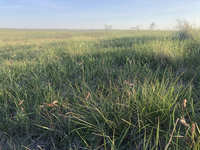NDSU Extension Offers Reasons to Graze or Not Graze this Fall
(Click the image below to view a high-resolution image that can be downloaded)
Late August and September rains have left drought stressed pasture and rangeland in some areas of North Dakota looking green and lush. Leading ranchers to wonder if they should take advantage of this forage, and how grazing will influence forage production in 2022?
“The answer to this question is going to depend largely on the grass species in the pasture,” says Miranda Meehan, North Dakota State University Extension livestock environmental stewardship specialist. “If the pasture is comprised of tame grass species such as brome grass or Kentucky bluegrass there should be no long-term negative impacts associated with grazing this fall as long as they don’t overgraze. Producers should pay especially close attention to native rangeland.”
“Many cool-season native species, that are dominant on rangeland in the state, are currently establishing tillers,” says Meehan. “Tillers will be used by these plants to initiate growth next spring. If this tiller is lost due to drought or grazing, the plant will need to develop a new tiller in the spring, delaying grass growth and development.”
Native grasses that were grazed prior to reaching the reproductive stage likely have seen regrowth with recent rains. If grazing native range this fall, be careful to monitor utilization and not overgraze to protect tiller development.
As a general rule of thumb, grasses should not be grazed below the second node or the area between the first and second leaf.
“It is recommended that ranchers avoid grazing pastures that received heavy use this grazing season to allow them to recover,” says Kevin Sedivec, NDSU Extension rangeland management specialist. “The stress of drought, in combination with over-use can have long term impacts on rangeland. Overgrazing affects the entire rangeland plant community, leading to a loss of plant species diversity and biomass, soil erosion and weed growth, and a reduction in the soil’s ability to hold water. Ultimately decreasing forage production and animal performance.”
Sedivec continues, “As we look forward to the 2022 grazing season, pastures will require special care next spring to help them recover from the drought. Ranchers should be prepared for a delay in grass growth and development.”
“If pastures are grazed too early, it will result in reduced leaf area and the plants’ ability to capture sunlight. Grazing too early will reduce plant vigor, thin existing stands, lower total forage production, and increase disease, insect and weed infestations. Pastures and range damaged by grazing too early may take several years of deferment or even rest before the stand regains productivity.”
“Unfortunately, there are many unknowns as we look toward the 2022 grazing season,” says Meehan. “Allowing pasture and rangeland to recover this fall will increase the ability of these grazing resources to recover from the drought. Now is the time to evaluate your grazing system to determine how you can increase flexibility and resilience of your grazing resources and ranch.”
For more information on grazing management, contact your local NDSU Extension agent or view the following NDSU Extension publications:
- “Ranchers Guide to Grassland Management IV” at https://tinyurl.com/brjw44fb
- “Strategies for Managing Drought in the Northern Plains” at https://tinyurl.com/2rj2vj8r
- “Determining Grazing Readiness for Native and Tame Pastures” at https://tinyurl.com/wz3ra875
NDSU Agriculture Communication – Oct. 6, 2021
Source: Miranda Meehan, 701-231-7683, miranda.meehan@ndsu.edu
Source: Kevin Sedivec, 701-424-3606, kevin.sedivec@ndsu.edu
Editor: Kristin Harner, 751-231-7875, kristin.harner@ndsu.edu


